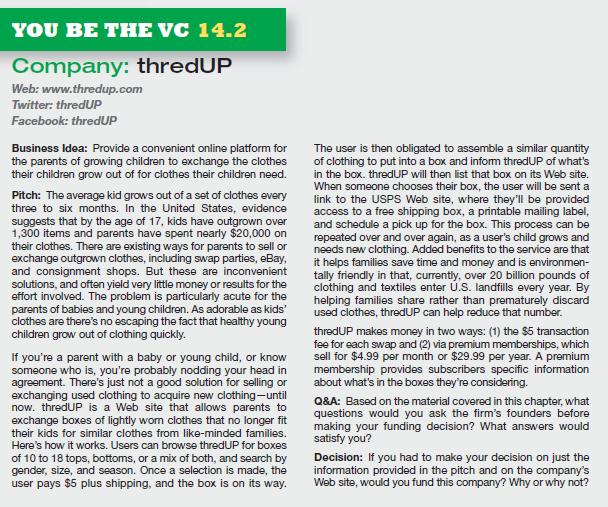For two main reasons, many entrepreneurial firms aspire to be bought by larger companies. First, by selling
Question:
For two main reasons, many entrepreneurial firms aspire to be bought by larger companies. First, by selling to a large firm, an entrepreneurial venture is able to create a liquidity event for its investors. Second, being acquired by a large company often allows a small firm to accelerate its growth and make good progress toward achieving its mission. Typically, a small firm often doesn’t have the marketing and distribution muscle to get wide market exposure. By selling to a large firm, a small firm’s products can take off by being integrated into the larger firm’s marketing program and distribution channels.
In 2007 StumbleUpon, an Internet start-up, sold itself to eBay for $75 million. StumbleUpon is a discovery engine (a form of Web search engine) that finds and recommends Web sites to its users. It was founded in 2001 by Garrett Camp and three friends while Camp was pursuing a masters’ degree at the University of Calgary.
StumbleUpon’s service grew in popularity over time and attracted $1.2 million in investment capital. The setup of its service allows users to “stumble upon” Web sites that they normally wouldn’t have known about. People who are passionate about StumbleUpon’s site say they like it because of the surprise factor of what they see next.
StumbleUpon makes money via targeted advertising.
The sites a user stumbles upon are not entirely random.
Advertisers can buy placements from StumbleUpon that ensure a certain number of page views from StumbleUpon users each day.
Unlike the rationale for a larger firm buying a small firm provided previously, it was never entirely clear why eBay bought StumbleUpon. The most likely scenario is that eBay felt it could grow StumbleUpon and benefit from its increased ad revenue. It was also thought that eBay might use StumbleUpon’s functionality to help eBay customers stumble through eBay’s listings, and potentially buy things they wouldn’t have thought to buy through the fun of discovering them via the “stumble across” format. Incredibly, just two years after eBay bought StumbleUpon, its founder, Garret Camp, and a group of investors bought it back, meaning that StumbleUpon is again a private company.
What went wrong?
In a very transparent interview with the Wall Street Journal, Garrett Camp chronicled the reasons the eBay acquisition didn’t work out. Camp and the majority of his team stuck with StumbleUpon during the two years it was owned by eBay, working on StumbleUpon as eBay employees. StumbleUpon was able to operate fairly autonomously, although it was part of eBay and subject to eBay’s oversight and administrative rules.
There were two categories of problems that prompted Camp to repurchase StumbleUpon from eBay.
First, by being part of a large company, Camp and his team lost lots of flexibility and control—in making decisions, troubleshooting problems, and hiring employees.
In short, they felt StumbleUpon’s entrepreneurial fire was being smothered. Little things were also troublesome.
For example, when they sent an offer letter to a job candidate it went out on eBay letterhead. They asked if they could put StumbleUpon’s logo on the letter, but there wasn’t a procedure to allow that to happen.
The second category of problems dealt with recruiting and hiring high-potential employees. First, the process of hiring was slower inside eBay than it was when StumbleUpon was an independent firm. That put StumbleUpon at a disadvantage when job candidates it was competing for were getting instant offers from private firms. Second, the stock price for a large company like eBay is fairly stable. That made it difficult for StumbleUpon to compete for top engineering talent. By going to work for a start-up or growing private firm, an engineer’s stock options are likely to accelerate in value much more quickly than working for a large firm like eBay.
Fortunately, this “What Went Wrong?” feature has a happy ending, at least from StumbleUpon’s perspective.
In late 2010, the firm announced that it had signed up its 10 millionth user, and said its number of advertisers climbed by 20 percent and its headcount by over 50 percent in 2010. StumbleUpon recently launched an iPhone and Android app as well.
Questions for Critical Thinking
1. Of the issues that were problematic for Camp and his team, in regard to growing StumbleUpon as an eBay subsidiary rather than as an independent firm, what single issue do you think was the most problematic?
2. Why do you think eBay allowed Camp and his investors to take StumbleUpon private again? Do you think there were frustrations on eBay’s part in working with Camp and his team?
3. What lessons does this feature teach the founders of rapidly growing entrepreneurial firms that are likely acquisition targets?
4. The “You Be the VC 14.2” feature focuses on thredUP, an online platform for the parents of growing children to exchange the clothes their children grow out of for clothes their children need. Identify a large company that might purchase thredUP if thredUP does well. From thredUP’s point of view, make of list of the advantages and disadvantage of being acquired by that company.
Step by Step Answer:

Entrepreneurship Successfully Launching New Ventures
ISBN: 9780132555524
4th Edition
Authors: Bruce R. Barringer, R. Duane Ireland





